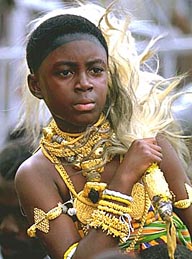Jan 25, 2016
Cultural Symbols of Ghana
The arts of a people offer an illuminating view of its culture - its thought processes, attitudes, beliefs, and values. The art of a particular culture can reveal ever changing human images and attitudes, so awareness of a people's indigenous art, visual and cultural symbols can become an important medium for cross-cultural understanding.
"Just as written documents [that utilize phonographs] materialize history in literate communities," as pointed out by Fraser and Cole (1972, p. 313), "so in traditional societies, art forms make the intangible past more real." Some of these art forms utilize pictograms and ideograms, and are pregnant with text that symbolizes ideas on several levels of discourse.
The various ethnic groups of Ghana have incorporated variety of cultural symbols in their arts in such media as ceramics, baskets, leather works, textiles, metal casing, wood carving, and architecture. For example, the Akan’s use of pictographs and ideograms reached its most elaborate forms in the regalia of the king's court. As Kyerematen (1964, p. 1) has written
"the regalia of Ghanaian chiefs have been of special significance in that they have not been merely symbols of the kingly office but have served as the chronicles of early history and the evidence of traditional religion, cosmology and social organization ... [and] it has been customary for the regalia to be paraded whenever the chief appears in state at a national festival or durbar so that all who see them may read, mark and inwardly digest what they stand for."
While the Akan are only one of the major ethnic groups in Ghana, it is largely recognized the widespread diffusion of Akan arts and culture traits into non-Akan areas of the country (Cole and Ross, 1977; Larbi, 1992). Cole and Ross, for example, point out the distinctive sociopolitical and humanistic emphasis of these arts, in which the subjects are people and ideas, not deities. They suggest that the underlying humanism of Akan arts is most clearly revealed in a recognition of the extent to which artistic motifs correspond with verbal expressions and ideas.
Warren and Andrews (1977) note that the aesthetic value of an Akan art piece is frequently based on the symbolic aspects of the work. Warren and Andrews also reveal that much Akan symbolism is esoteric knowledge which is only well known by a small number of art specialists and few people associated with the royal court.

